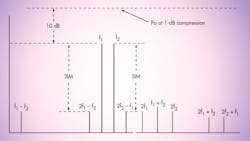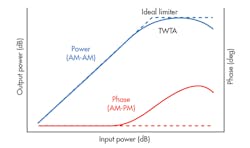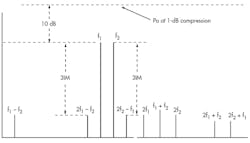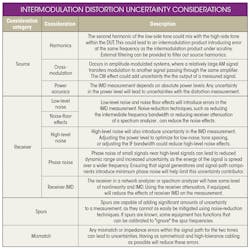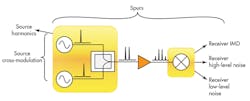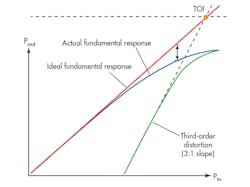Top Methods for Measuring 5 Common Signal-Corrupting Distortions
This file type includes high resolution graphics and schematics when applicable.
The intrinsic imperfections of devices and the materials that comprise them lead to non-ideal electrical relationships. Nonlinear relationships among power, current, voltage, and phase cause complex responses, which are generally difficult to model. Anything from poorly connected metal structures to internal material properties can induce such relationships.
Ultimately, these nonlinear effects limit component/device performance. Their resultant signals are referred to as distortion products. Engineers must figure out how to effectively measure and mitigate several different categories of distortion products using design or manufacturing techniques. Five of the most common distortion challenges are:
1. Harmonic Distortion
Harmonic implies the development of integer multiples of a series. With harmonic distortion, a distortion product of an input signal appears as the function of a series over an infinite range of frequencies. A nonlinear voltage and current relationship causes harmonic distortion, represented as complex mathematical products. Generally, the first few harmonic products are the most significant—as the power diminishes, the order of the harmonic product rises in parallel. Eventually, these harmonic products fade into the noise floor.
Harmonic-distortion products are generally consistent within a device. Because they are a function of the input signal, careful filtering can often remove the most troublesome harmonic products. Unfortunately, harmonic products may also appear near or within the transmit/receive bands in multi-frequency systems, effectively reducing the dynamic range.
2. Intermodulation Distortion
Intermodulation distortion (IMD) is caused when multiple frequencies are mixed to form sum and difference products of the original signals. These signals occur as integer multiples of the input frequencies (spurs). Often, they impact the operation bands of the devices. Several IMD products can occur within the same receive or transmit band, depending on the input signals and operation bandwidths.
IMD products can be both harmonic and nonharmonic. As a result, predicting and mitigating IMD-generated spurs is both complex and error-prone. If the input signals vary in frequency—in tandem or not—the IMD products will change in both frequency and power. Small component and material imperfections can cause IMD. Examples include dissimilar metal contact, surface corrosion, or intrinsic material properties.
When non-active components cause IMD effects, it’s known as passive intermodulation (PIM) distortion. Often, devices and components must be rigorously tested to ensure that they operate with low IMD or low PIM. These nonlinear effects tend to increase with cascaded nonlinear component characteristics.
3. Cross-Modulation and Crossover Distortion
Like intermodulation distortion, cross-modulation distortion occurs when two signal characteristics mix together. If two or more input signals are received, the modulation on one signal—caused by nonlinear receiver circuit behavior—can modulate the other input signals. Cross-modulation can dramatically decrease a receiver’s dynamic range, especially under high orders of modulation. To limit the effects of this distortion, the receiver front end must be operating linearly.
When a device changes operating modes (such as a transistor switching or changing bias conditions), its characteristic behavior may be nonlinear during that period. This nonlinear transition period can result in intermittent distortion products, known as crossover distortion. The nonlinear transition characteristics of a device may be inconsistent and depend on difficult-to-model effects. As a result, care must be taken to mitigate the nonlinearity of device operating-mode transitions.
4. Phase Distortion
Akin to the nonlinear response between current and voltage, a nonlinear response in the device’s phase and frequency response often introduces distortions. These phase distortions can induce “echo” responses in the time domain, which may be difficult to interpret for root cause. Moreover, many wireless technologies rely on time-division duplexing, where the differentiating factor between two signal streams is a frame of time. As signal echoes cascading through such systems, they may degrade subsequent signal streams.
5. Distortion Memory and Memory Effects
Some component materials will store small amounts of energy. Over time, this energy may be released at varying frequencies and power levels. These “memory” effects are not always consistent. Occasionally, they will cause distortions or increase the difficulty in modeling a device’s distortion-generating characteristics. Memory effects are particularly concerning for power amplifiers, which employ predistortion and envelope-tracking techniques. These techniques rely on data tables based on consistent device behavior that’s degraded by memory effects.
5 Ways to Measure Distortion and Distortion Metrics
To make design or manufacturing changes that mitigate distortion effects, engineers need detailed knowledge of the different root causes of distortion products. Such information is derived from measurements, simulations, and analysis. Because different effects produce the different types of distortion, a battery of tests is needed to effectively detail each distortion contributors:
1. Two-Tone Distortion Measurement (IP3/IPN)
By using two precisely defined and highly linear tones, a signal/spectrum analyzer will be able to measure a device’s distortion products. If the total power of the two tones is well known, it’s possible to compare the power of the distortion products. Then a relationship can be developed between frequency and power. This two-tone distortion measurement is often performed with two synchronized and symmetrical sources set to a precise difference in frequencies.
An extremely high-isolation power combiner is used to merge the input signals from the sources into the device’s input. Next, the device output is input to a signal/spectrum analyzer. Depending on the power levels, an attenuator may be used to lower the input signal’s strength to prevent distortion or damage from the analyzer.
Consistent criteria for defining a device’s harmonic/intermodulation quality can be beneficial for amplifiers and mixers at various power levels. Typically, employing a power-in/power-out ratio plot with the ideal fundamental response and third-order distortion product can aid an objective comparison. The third order intercept (TOI) is the imaginary point at which the linear slopes of the ideal fundamental response and third-order distortion slope connect. If the TOI is read from the input, it’s known as the input intercept point (IIP, IIP3, or IP3). If read from the output, it’s defined as the output intercept point (OIP or OIP3). Using the OIP may provide additional insight into the compression effects of a device over multiple measurements.
2. Noise Power Ratio
Using noise as a stimulus to measure a system’s nonlinear effects is a broadband measurement approach that can be performed rapidly over large frequency swaths. In multichannel telecommunications systems, channels can be populated with noise via a broadband noise generator. Comparing the noise in populated channels to an unpopulated channel provides a ratio of the contribution of broadband distortion products to that specific channel (known as noise power ratio, or NPR).
Generally, an arbitrary waveform generator (AWG), synthesizer, and signal/spectrum analyzer perform NPR measurements. The AWG is set to create the noise signal with the desired characteristics. The synthesizer ensures that the noise power is upconverted and placed in the selected channels. And the signal/spectrum analyzer detects the difference in the noise-populated channels and unpopulated channel to deliver the NPR measurement iteratively for various channels.
For telecommunications systems, the NPR can be used to measure the total effects from distortions—possibly replacing IP3 in some cases. After all, the NPR may provide a path to a much faster and more easily automated test.
3. 1-dB Compression Point (P1dB)
At some input power level, intrinsic device and material properties will eventually develop a nonlinear power-in/power-out response. To avoid significant nonlinear behavior, such as a power amplifier, receiver, or mixer, most devices are run below a point of significant linearity degradation. This point, the 1-dB compression point, is described as the input power level at which the output power drops 1 dB below the ideal linear response. Generally, a single adjustable power source is swept through a range of input powers to a device. The output of the device is directed to a signal/spectrum analyzer, where the device output is measured. Often, the analyzer has an attenuator at the front end of its receiver to prevent receiver compression, which degrades the measurement accuracy.
4. Adjacent-Channel Power Ratio (ACPR)
Adjacent-channel power ratio best describes highly modulated signals over two-tone sinusoidal measurements. It measures the power at an adjacent channel compared to the primary channel. Such a measurement enables a modulated signal source. It replicates the device’s intended use more accurately, since it represents real-world distortion characteristics. In addition, alternate-channel power ratio is used to describe the power ratios between the primary channel and the bandwidths spaced two channel distances away from the primary.
5. Error Vector Magnitude (EVM)
Error vector magnitude, also referred to as receive constellation error (RCE), is a relatively comprehensive measure of the non-ideal effects of a digitally modulated transmitter or receiver. Thus, distortion products are also embedded within the measurement. Coupling EVM with other distortion-analysis measurements can reveal additional information regarding how the distortion effects impact overall system performance.
This file type includes high resolution graphics and schematics when applicable.
EVM is determined by measuring either the power error or percent error difference between the ideal constellation point and the received/transmitted constellation point. The error vector is a vector drawn in the I-Q plane between the ideal and actual constellation point. Generally, the average power of the error vector normalized to the signal power is taken as the power EVM (the root-mean-square, or RMS, average for percentage EVM). Many signal analyzers automatically provide EVM measurements for known forms of modulation, though this type of analysis may require additional software packages.
Resources:
Compensation of nonlinear distortion in RF amplifiers for mobile communications
Testing For Nonlinear Distortion in Cable Networks
Intermodulation Distortion Measurements on Modern Spectrum Analyzers
Millimeter-wave Intermodulation Distortion Measurements
Intermodulation Distortion Measurements
Optimizing IP3 and ACPR Measurements
The IP3 Specification - Demystified
Interaction of Intermodulation Products between DUT and Spectrum Analyzer
About the Author
Jean-Jacques DeLisle
Jean-Jacques graduated from the Rochester Institute of Technology, where he completed his Master of Science in Electrical Engineering. In his studies, Jean-Jacques focused on Control Systems Design, Mixed-Signal IC Design, and RF Design. His research focus was in smart-sensor platform design for RF connector applications for the telecommunications industry. During his research, Jean-Jacques developed a passion for the field of RF/microwaves and expanded his knowledge by doing R&D for the telecommunications industry.
